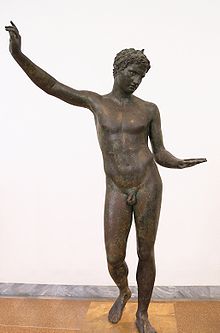- Marathon Boy
-
Contents
Movie
'Marathon Boy' is the title of a feature-length documentary movie on Budhia Singh, directed by Gemma Atwal. [1]
Statue
The Marathon Boy or Ephebe of Marathon is a Greek bronze sculpture found in the Aegean Sea in the bay of Marathon in 1925; it is conserved in the National Archaeological Museum of Athens,[2] where it is dated ca 325-300 BCE. The Museum suggests that the subject may be a youthful depiction of Hermes, though none of the god's attributes are present. With its soft musculature and exaggerated contrapposto, its style manifests the influence of Praxiteles on his contemporaries; it is the closest contemporary reflection of Praxiteles' manner.[3]
His upraised arm and the distribution of his weight demonstrate that in his original context, this ephebe was leaning against a vertical support, such as a column.[4]
Before the advent of scuba diving, its chance recovery suggested the possibility that artistic as well as archaeological treasures had been preserved from human destruction in underwater sites. Other well-known underwater bronze finds have been retrieved, generally from shipwreck sites, in the Aegean and Mediterranean: the Antikythera mechanism, the Antikythera Ephebe and the portrait head of a Stoic discovered by sponge-divers at Antikythera in 1900, the Mahdia shipwreck off the coast of Tunisia, 1907; the standing Poseidon of Cape Artemision found off Cape Artemision in northern Euboea, 1926; the horse and Rider found off Cape Artemision, 1928 and 1937; the Getty Victorious Youth dredged up off the coast of Fano, Italy; the Riace bronzes, found in 1972; the Dancing Satyr of Mazara del Vallo, in the Sicily Channel, 2003; and the Apoxyomenos recovered from the sea off the Croatian island of Lošinj in 1999.
Notes
- ^ Marathon Boy Documentary
- ^ Inv. no. X 15118.
- ^ Most of the Praxitelean repertory consists of Roman marble copies and interpretations. The Louvre's request for the Ephebe for the 2007 exhibition Praxitèle was refused by the Hellenic Ministry of Culture, 10 February 2007.
- ^ The unusual stance was noted by Gisela Richter, "The Hermes of Praxiteles" American Journal of Archaeology 35.3 (July - September 1931:277-290) p. 280, crediting W. Wrede, in Arch. Anz. 1926:401 with the observation.
External links
- (Hellenic Ministry of Culture) The Metals Collection, National Archaeological Museum, Athens
- "The Marathon Boy and the Satyr" Comparable Roman marbles of a Satyr pouring wine]
http://www.marathonboymovie.com
Categories:- Ancient Greek sculptures
- Art of ancient Attica
Wikimedia Foundation. 2010.

